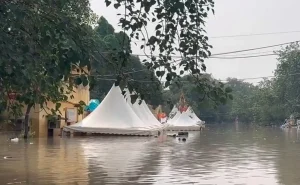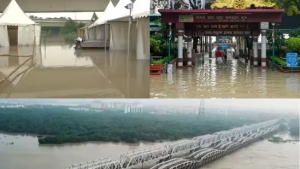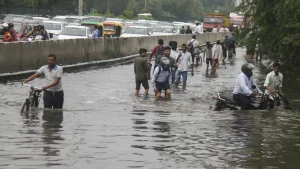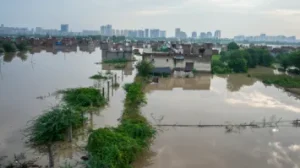New Delhi – The Yamuna Floods have created unprecedented chaos across Delhi as the river continues flowing well past the established danger mark on Thursday. The water level at Delhi’s Loha Pul or Old Railway Bridge measured 207.48 metres between 6 am and 7 am, according to official data, highlighting the severity of the current flooding situation.
The Yamuna Floods have transformed the national capital’s landscape, with floodwaters reaching critical infrastructure and residential areas. From major roads to crematorium grounds, the rising waters have inundated numerous locations across Delhi, creating widespread disruption for residents and businesses alike.
Relief Camps Overwhelmed by Rising Waters

The Yamuna Floods have even penetrated relief camps established for evacuees, with visuals showing facilities near Mayur Vihar Phase-1 completely submerged. This unprecedented situation has created additional challenges for authorities managing the evacuation efforts and providing safe shelter for displaced residents.
Despite these setbacks, the revenue department has successfully relocated thousands of people from vulnerable areas. According to official reports, 8,018 people have been shifted to temporary tents, while 2,030 individuals have been moved to 13 permanent shelters as the Yamuna Floods continue threatening low-lying areas near the river.
Commercial Areas Face Severe Disruption

The Yamuna Floods have severely impacted commercial districts, with areas like Yamuna Bazar and Monastery Market remaining completely submerged. Shopkeepers and vendors at Monastery Market began moving their inventory early morning, anticipating further water level rises as the Yamuna Floods intensified throughout the day.
Business owners recalled similar preparation scenes from the devastating 2023 floods, demonstrating how the Yamuna Floods have become a recurring threat to Delhi’s commercial infrastructure. Hundreds of people reportedly remain stuck in colonies behind the market areas, unable to evacuate due to the rapidly rising floodwaters.
Also Read: Thousands Prepare to Evacuate as Yamuna Crosses Danger Level Mark At 207.39 Meters
Civil Lines Severely Affected
The Civil Lines area has reported severe waterlogging problems as the Yamuna Floods continue expanding their reach. Vehicles, buildings, and staircases leading to overhead bridges have all been completely submerged under the overflowing river water, making transportation and daily activities virtually impossible in the affected zones.
The Yamuna Floods have also reached dangerously close to the Delhi Secretariat, raising concerns about potential disruption to government operations and administrative functions. This proximity to critical government infrastructure highlights the extensive geographical impact of the current flooding crisis.
Crematorium Operations Severely Disrupted
The Yamuna Floods have forced significant changes to funeral services across Delhi, with Nigambodh Ghat, the capital’s oldest and busiest cremation ground, completely halting operations. The facility managed to conduct cremations until 3 pm on Wednesday before the river water reached the main pyre area, forcing officials to turn away grieving families.
At Geeta Colony crematorium, operations continue despite the Yamuna Floods creating challenging conditions. Sanjay Sharma, the crematorium head, reported water levels reaching approximately 10 feet deep, with extensive damage to stored wood supplies. The facility continues operating as other cremation grounds have shut down, forcing people to travel from distant locations.
Transportation Infrastructure Compromised


The Delhi Metro Rail Corporation has issued advisories regarding the Yamuna Floods’ impact on public transportation. The approach road to Yamuna Bank Metro Station has become completely inaccessible due to escalating water levels, though the station itself remains operational with interchange facilities available.
The Delhi Metro authorities have advised passengers to plan their journeys accordingly and consider alternative routes while the Yamuna Floods continue affecting transportation infrastructure. This disruption adds to the broader challenges faced by residents navigating the flooded capital.
Infrastructure Damage Beyond Flooding


Beyond the immediate Yamuna Floods impact, Delhi has experienced additional infrastructure failures. A portion of the flyover on National Highway 44, under Alipur police station jurisdiction, collapsed Thursday following incessant rainfall over recent days. This incident demonstrates how sustained weather conditions have weakened the city’s infrastructure beyond just flood-related damage.
The combination of the Yamuna Floods and structural failures has created a comprehensive crisis requiring coordinated emergency response efforts across multiple government departments and agencies.
Weather Forecast and Future Outlook
The India Meteorological Department has forecast thunderstorms with rain for Thursday, followed by generally cloudy skies with moderate rainfall on Friday, September 5. Minimum temperatures are expected around 21 degrees Celsius, while maximum temperatures should reach approximately 33 degrees Celsius.
Currently, no specific weather warnings have been issued for Delhi or NCR areas on the meteorological department’s nowcast warning system, though the Yamuna Floods situation continues requiring close monitoring as water levels remain above safe thresholds.
Emergency Response Continues
As the Yamuna Floods persist, authorities maintain round-the-clock monitoring and evacuation efforts. The situation demonstrates the ongoing vulnerability of Delhi’s infrastructure to seasonal flooding and the need for comprehensive long-term solutions to prevent future disasters of similar magnitude affecting the national capital’s millions of residents.

